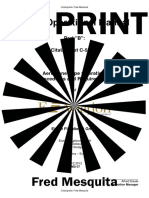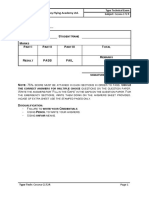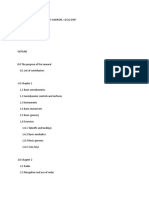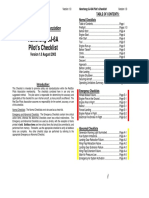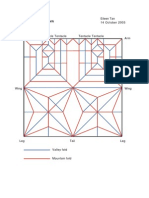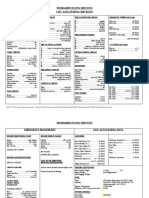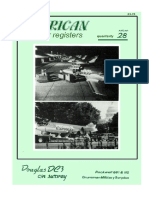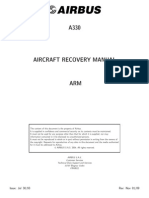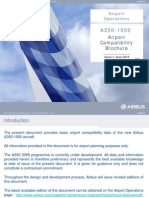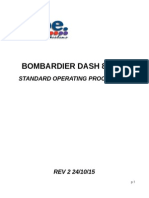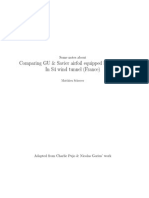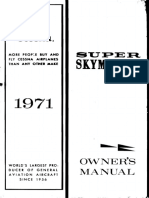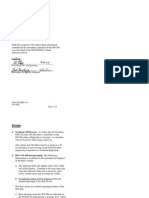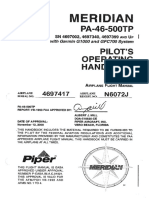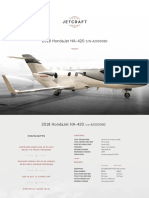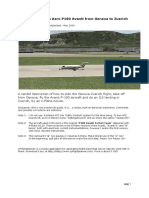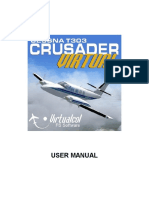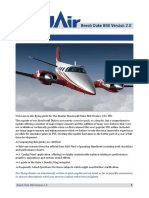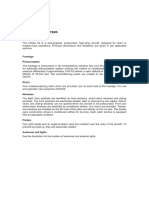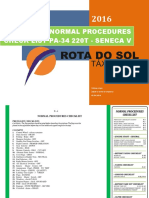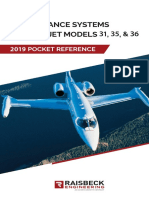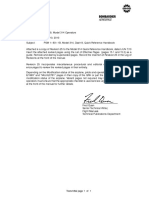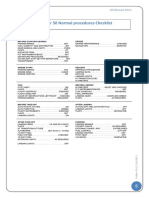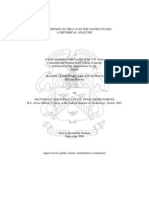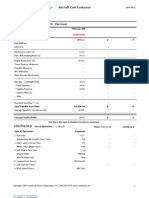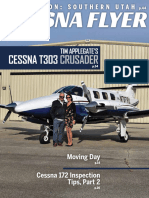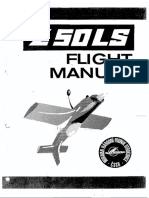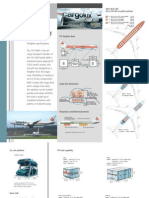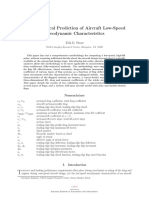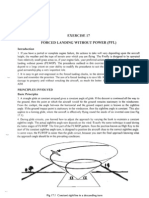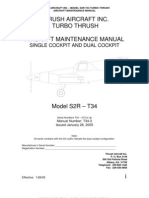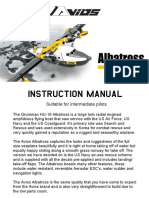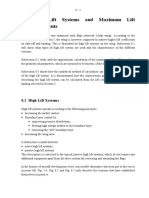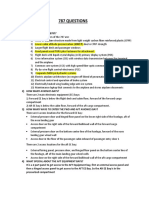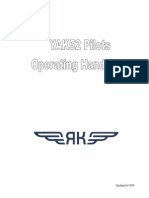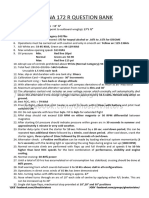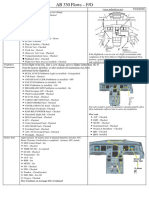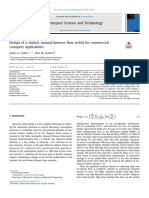707 300 Limitations
707 300 Limitations
Uploaded by
Matias Javier AlvarezCopyright:
Available Formats
707 300 Limitations
707 300 Limitations
Uploaded by
Matias Javier AlvarezOriginal Description:
Copyright
Available Formats
Share this document
Did you find this document useful?
Is this content inappropriate?
Copyright:
Available Formats
707 300 Limitations
707 300 Limitations
Uploaded by
Matias Javier AlvarezCopyright:
Available Formats
Legendary 707 (For MSFS 2004 ONLY)
Legendary 707
Flight and Training Manual
Part II OPERATIONS MANUAL
FOR FLIGHT SIMULATION USE ONLY
2004 Captain Sim www.captainsim.com
Legendary 707 (For MSFS 2004 ONLY)
LEGENDARY 707 FLIGHT MANUAL
Part II OPERATIONS MANUAL
1. OPERATING LIMITATIONS
1.1 GENERAL LIMITS
1.2 AIRPLANE LIMITS
2. NORMAL PROCEDURES
2.1 GENERAL
2.2 START-UP
PROCEDURE (SOP)
2.3 TAKE OFF AND DEPARTURE PROCEDURES (SOP)
2.4 CRUISE PHASE (SOP)
2.5 DESCENT (SOP)
2.6 APPROACH (SOP)
2.7 LANDING (SOP)
2.8 AFTER LANDING (SOP)
2.9 FLIGHT DIAGRAMS (SOP)
2004 Captain Sim www.captainsim.com
Legendary 707 (For MSFS 2004 ONLY)
1. OPERATING LIMITATIONS
1.1 GENERAL LIMITS
CREW
All flights require a minimum flight crew of three persons pilot, copilot (first officer (FO)) and flight
engineer (second officer (SO)).
THE MINIMUM NUMBER OF CABIN ATTENDANTS (FOR PASSENGER VARIANTS ONLY)
For revenue passenger operations depends on the number of passenger seats in the interior configuration,
as follows:
2 attendants -- 100 seats or less;
3 attendants -- more than 100, less than 151 seats;
4 attendants -- 151 seats or more.
ENGINE ANTI-ICE
The engine ice protection systems shall be operated continuously as an anti-icing system in icing conditions.
ENGINE IGNITION
Engine ignition must be ON for take-off and initial climb.
REVERSE THRUST
Inflight use of reverse thrust is prohibited.
ICING CONDITIONS ENROUTE
During holding or prolonged flight in icing conditions, operation with wing flaps extended is not permitted.
PARKING
When parking the airplane, retract wing flaps to lock outboard ailerons for control lock gust protection.
1.2 AIRPLANE LIMITS
Max
Max
Max
Max
Max
Max
Max
operating altitude:
T/O &Landing altitude:
runway slope:
T/O, landing tailwind:
crosswind T/O, landing:
flaps extension altitude:
speed:
42,000ft (FL420)
10,000ft
+ 2% for take-off and landing
10 knots (kts)
33knots (kts)
20,000 ft.
Vmo/Mmo shall not be deliberately exceeded in any
regime of flight (climb, cruise, or descent), except
where a higher speed is specifically authorized for flight
test or pilot training operations, or in approved
emergency procedures.
MAXIMUM OPERATING LIMIT SPEEDS
FL
S.L.
5,000 ft
10,000 ft
15,000 ft
20,000 ft
23,000 ft
Higher
Vmo/Mmo
375 kts
378 kts
382 kts
385 kts
390 kts
394 kts
M
0,887
FLIGHT LOAD ACCELERATION LIMITS
Flaps UP: + 2.5 G (T/O weight) - -0.6G
Flaps DOWN: + 2.06G (Landing Weight 0.0G)
2004 Captain Sim www.captainsim.com
Legendary 707 (For MSFS 2004 ONLY)
PERFORMANCE LIMITATIONS
Take-off and landing operational limits must be observed.
Maximum
Maximum
Maximum
Maximum
taxi weight (structural limit):
TOGW (at start of take-off roll):
landing weight (MLW):
zero fuel weight (ZFW) (structural limit):
336,000
333,100
215,000
195,000
lbs
lbs
lbs
lbs
LANDING GEAR OPERATING SPEED VLO/MLO
Sea level (SL) to 30,000 ft:
270 kts
Above 30,000 ft:
280 kts
For emergency descent:
320 kts
Mlo:
0,825
Max Landing Gear Extended Speed (Vle):
320 kts, Mle: 0,825
MAX FLAPS EXTENDED SPEED (Vfe)
Flaps 14 -Flaps 25 -Flaps 40 -Flaps 50 --
218
207
200
181
kts
kts
kts
kts
AUTOPILOT OPERATING SPEED
Do not exceed Vmo/Mmo
STABILIZER TRIM SETTING LIMITATIONS
Stab Trim Index should be in the green band for take-off
TEMPERATURE LIMITS (OUTSIDE AIR TEMPERATURE OAT C)
Min OAT:
- 54C for take-off and landing;
-73,4C for enroute flight path
Max OAT, T/O and Landing: not to exceed +49C
ENGINE LIMITATIONS
Engine Overspeed Limits (Forward or Reverse)
N1 -N2 -Operating Condition
Max EGT
C
450
-555
below 110,8 %
below 106,2%
Max Oil Inlet Temp.
C
-132
132
Oil pressure, PSI
Max
Starting (momentary)
-Idle
60
Takeoff, Go-around
60
(5 minutes)
Rated (continuous)
490
132
40
60
Max Cruise
490
132
40
60
(continuous)
Takeoff thrust is limited by EPR, observing RPM and EGT limits
The oil-in temperature limit is 132 C for continuous operation and 143 C for transient
operations. Oil-in temperature may not exceed 132 C for more than 15 minutes.
2004 Captain Sim www.captainsim.com
Min
-35
40
Legendary 707 (For MSFS 2004 ONLY)
OPERATIONAL NOTE:
IF ENGINES ARE ALREADY STARTED, to continue flight configure
electrical and air system as follows:
Battery switch (13)CHECK ON (SO UPPER RANEL)
Generator circuit breaker switches (34-37)CLOSE (observe lights coming out)
Left & Right Wing Valve Switches (76-77) - BOTH OPEN (SO UPPER PANEL)
If the generators cannot be connected on bus, proceed as follows:
Generator control switches (42-45)-CLOSE (observe Generator control lights (38-41 coming out).
Generator bus-tie circuit breakers (26-29)-OPEN (observe Generator circuit open lights (22-25)
coming out).
2. NORMAL PROCEDURES
2.1 GENERAL
All flights assumes you are using Standard Operating Procedures (SOP)
NOTAM: SOP assumes you are beginning with engines are cleared to start (for START UP procedures refer
to 2.2) at the departure gate (or at the selected runway (RW)) and:
exterior safety inspection
preliminary cockpit preparation
final cockpit preparation
before start checklist
after start checklist
before take-off checklist
completed
completed
completed
completed
completed
completed
In all situations and phases of flight you act as a Pilot Flying (PF) AND DO ONLY CRITICAL ITEMS
(CRITS)
This aircraft's SOP have been modified for use with Flight Simulator . It must not be used for real-world flight
operations.
TAKE-OFF AND DEPARTURE CRITS:
EXTERIOR LIGHTS (L BUTTON OR FROM THE FLIGHT DECK).
EPR AND AIRSPEED BUGS.
STABILIZER TRIM INDEX
FLAPS.
RADIOS, RADAR, ADFs, TRANSPONDER, VOR/ILS..
AS REQUIRED
CHECKED AND SET FOR T/O(V1,VR,V2)
IN THE GREEN BAND FOR T/O
SET FOR T/O
TUNED AS REQUIRED FOR DEPARTURE
ATER TAKEOFF CRITS:
LANDING GEAR
FLAPS
UP (NO LIGHTS)
UP (NO LIGHTS)
DESCENT AND APPROACH CRITS:
APPROACH BRIEFING .
ALTIMETERS & INSTRUMENTS (altitude, airspeed, EPR bugs) ..
REVIEWED
CHECKED&SET
LANDING CRITS:
LANDING GEAR........
FLAPS.
2004 Captain Sim www.captainsim.com
DOWN, 3 GREEN
40 OR 50 OR AS REQUIRED, GREEN LIGHTS
Legendary 707 (For MSFS 2004 ONLY)
2.2 START-UP
PROCEDURE
IF ENGINES ARE ALREADY STARTED, configure electrical and air system as follows:
Battery switch (13)CHECK ON (SO UPPER RANEL)
Generator circuit breaker switches (34-37)CLOSE (observe lights coming out)
Left & Right Wing Valve Switches (76-77) - BOTH OPEN (SO UPPER PANEL)
If generators cannot be connected on bus, proceed as follows:
Generator control switches (42-45)-CLOSE (observe Generator control lights (38-41 coming out).
Generator bus-tie circuit breakers (26-29)-OPEN (observe Generator circuit open lights (22-25)
coming out).
IF ENGINES ARE TO BE STARTED:
BATTERY SWITCH (13)CHECK ON (SO UPPER RANEL).
Left & Right Wing Valve Switches (76-77) - BOTH OPEN (SO UPPER PANEL)
START-UP USING CTRL+E
BUTTONS
Starting sequence will be 1,2,3,4, or from the lowest No. of engine to be started.
START USING EXTERNAL POWER
1. Parking brake---CHECK ON (CTRL+or directly by the handle)
SO UPPER PANEL--SELECT (FROM ICONS PANEL (SHIFT+2))
2.
3.
4.
5.
6.
External power--CONNECT (SHIFT+G)
External power connected light (amber) --CHECK ON
Check Duct high (86) and low (87) pressure indicators rising
Ground service master switch (20)-ON
Power on BUS light (blue (19))-CHECK ON
Now engines are ready to start: CTRL+E BUTTONPUSH
After all engines are stabilized at idle:
1. Generator circuit breaker switches (34-37)CLOSE (observe lights coming out)
2. External power--DISCONNECT (SHIFT+G) or by brakes releasing
3. Ground service master switch (20)--OFF.
START USING the APU (Where installed)
SO UPPER PANEL
APU PANEL
1.
2.
3.
4.
5.
6.
SELECT (FROM ICONS PANEL (SHIFT+2))
SELECT (FROM ICONS PANEL (SHIFT+2))
APU master switch---------------------------------------------ON (observe APU EGT rising)
Check Duct high (86) and low (87) pressure (SO UPPER PANEL) indicators rising
Generator Field Switch
(7 on the APU PANEL) ---------CLOSE (observe light came out)
Generator Breaker Switch (3 on the APU PANEL) ---------CLOSE (observe light came out)
Ground service master switch (20)---------------------------ON
Power on BUS light (blue (19))--CHECK ON
Now engines are ready to start: CTRL+E BUTTON-PUSH
After all engines are stabilized at idle:
1. Generator circuit breaker switches (34-37)CLOSE (observe lights coming out)
2. APU-(if not further required)-- OFF (APU master switch OFF)
3. Ground service master switch (20) - OFF
2004 Captain Sim www.captainsim.com
Legendary 707 (For MSFS 2004 ONLY)
Turbocompressors for takeoff
Normally the takeoff is made with two turbocompressors on (usually numbers 2 and 3); engine bleeds are
not to be used for any takeoff. A higher gross weight may be authorized for takeoff with one or both off. To
start desired turbocompressors and configure air-conditioning system:
1. Turbocompressor start/stop switches (71-73) START
2. Wing valve switches (76-77) - OPEN
3. Left & Right air-conditioning unit ON/OFF switches (84-85) ON
START-UP USING ENGINE START SWITCHES
GROUND START
Make all BEFORE START ITEMS as described above (STEPS 1 trough 6), then:
1. LEFT & RIGHT WING VALVE SWITCHES (76-77) - OPEN (SO UPPER PANEL)
2. Engine start switches (40-43) of the respective engine START & HOLD until EGT increases
(OVERHEAD (OH) PANEL)
After all engines are stabilized at idle:
1. Generator circuit breaker switches (34-37)CLOSE (observe lights coming out)
2. Another after start itemsAS DESCRIBED ABOVE
INFLIGHT START
Any time you want to start engines inflight PROCEED AS FOLLOWS:
1. CHECK THAT Engine Fire Handles and Warning Lights ARE PUSHED (LIGHTS OUT)
2. CHECK THAT Engine 1,2,3,4. Fuel shutoff valve switches are in the OPEN position (7,8,14,15 on the SO
LOWER PANEL)
3. CHECK THAT Left & Right Wing Valve Switches (76-77) - BOTH OPEN (SO UPPER PANEL)
4. CHECK THAT the Duct high (86) and low (87) pressure (SO UPPER PANEL)-EXISTS (IF NOT-USE ANY of
the Turbocompressor start/stop switches (71-73), or any of the Engine bleed air switches (74,75,78,79 ON
SO UPPER PANEL), or the APU as the pneumatic source TO CREATE IT)
5. CHECK THAT AT LEAST ONE source of electrical power is connected to the POWER BUS(if no
engines are running- use APU as the electric and pneumatic power source, as described above in the start up
procedure, using the APU) that means:
APU PANEL--------SELECT (FROM ICONS PANEL (SHIFT+2))
1.
2.
3.
4.
5.
6.
APU master switchON (observe APU EGT rising)
Check Duct high (86) and low (87) pressure (SO UPPER PANEL) indicators rising
Generator Field Switch
(7 on the APU PANEL) ---CLOSE (observe light came out)
Generator Breaker Switch (3 on the APU PANEL) -- CLOSE (observe light came out)
Ground service master switch (21 on the SO UPPER PANEL)--ON
Power on BUS light (blue (19) on the SO UPPER PANEL) ----- CHECK ON.
NOW ENGINES ARE READY TO START:
6. Use CTRL+E or Engine start switches (40-43) of the respective engine (START & HOLD until EGT
increases) procedures to start Engines.
After all engines are stabilized at idle (or as desired):
1. Generator circuit breaker switches (34-37)CLOSE (observe lights coming out)
2. Configure Air conditioning and pressurization system- AS DESIRED.
2004 Captain Sim www.captainsim.com
Legendary 707 (For MSFS 2004 ONLY)
2.3 TAKE OFF AND DEPARTURE PROCEDURES (SOP)
TAKE-OFF AND DEPARTURE CRITS:
EXTERIOR LIGHTS (L BUTTON OR FROM THE FLIGHT DECK)
EPR AND AIRSPEED BUGS
STABILIZER TRIM INDEX
FLAPS
RADIOS, ADFs, TRANSPONDER, VOR/ILS
AS REQUIRED
CHECKED AND SET FOR T/O(V1,VR,V2)
IN THE GREEN BAND FOR T/O
SET FOR T/O
TUNED AS REQUIRED FOR DEPARTURE
The use of standard T/O procedures will be assumed. The pilot making take-off (YOU) will advance the
throttles to about 0.10 below take-off EPR-bug value.(The engineer (SO) will trim the engines for take-off
thrust and monitor the power throughout the take-off regime).Once they are set, the Captain (YOU),will
position his hand on the throttles until V1. The captain (YOU) will make any decision to discontinue the takeoff and will execute the Rejected Take-off (RTO) procedures. (During a rejected takeoff, when the Captain
begins nose wheel steering, the First-Officer will keep nose wheel firmly on the ground and the wings level).
THIS TABLES SHOW YOU AN EXAMPLES OF SETTINGS OF EPR,N1%, REQUIRED FOR TAKEOFF AND GOAROUND,
V1,Vr,V2 VALUES, REQUIRED FOR TAKEOFF, THAT WERE USED IN THE ONE REALLY EXISTED 707.
TAKEOFF
OAT,C
-30
EPR
1,87
N1%
97,9
-20
1,83
99,5
AND
GO-AROUND
-15
-10
-5
+10
+15
+20
+30
1,82
1,82
1,82
1,82
1,82
1,82
1,82
1,82
100,8
101,8
102,8
103,7
105,7
106,7
107,6
109,2
TAKEOFF
TO GW
LBx1000
THRUST
SPEEDS
165 &
Below 175 185 200 215 230 245 260 270 280 290 300 310 320 325 333
V1
102 104 108 112 116 120 123 127 130 133 136 138 142 145 146
148
Vr
103 107 111 116 119 123 127 132 135 138 142 144 148 150 152
154
V2
120 124 127 132 136 141 146 150 152 155 158 161 163 165 167
168
AIRPLANE CONTROL
Take off positioning
Takeoff performance calculations presume the use of all available runway. Good judgment dictates that a
minimum amount of the runway be used in positioning for takeoff.
The first point at which thrust may be increased varies with the runway and taxiway layout. Avoid making
sharp turns onto the runway at high thrust
Applying take-off thrust
On all airplanes, set the chart rolling takeoff EPR values. When allied with the runway(RW):
Advance throttles smoothly
Pause until all engines have accelerated and are stabilized at 60% to 65%N1
If using brakes, ease them off (press.)
Smoothly advance throttles to about 0.10 below takeoff EPR-bug value
2004 Captain Sim www.captainsim.com
Legendary 707 (For MSFS 2004 ONLY)
Caution: Be especially careful to advance throttles symmetrically on slippery runways, in crosswinds, and at
light weights, in order to avoid directional problems.
Between 40 and 80kts, adjust thrust to bug value. Do not readjust EPR after 80kt except to stay within EGT
or N1-N2 limits.
Rotation
The rotation maneuver should be a smooth continuous pitch change to the V2+10kts climb attitude. Begin
the rotation maneuver approaching Vr at a rate that causes the nose wheel to leave the ground at Vr. The
airplane should reach the target climb attitude and V2+10 simultaneously.
Caution: If the airplane is not airborne at 10 degrees pitch, stop rotation until liftoff occurs, then adjust
attitude as described above to reach V2+10.
V2+10
Weight,lbsx10
00
Pitch, degrees
205 or less
205-230
18
17
climb
230-255
attitude
255-280
16
15
280-305
14
305&higher
13
Retract the gear (G or from joystick) when a positive rate of climb is indicated on the pressure altimeter.
Landing gear retraction increases drag while the gear doors are open.
Initial climb
After establishing the initial climb attitude by reference to the attitude indicator (ADI), monitor the airspeed
and adjust the pitch attitude to maintain V2+10,to a maximum of 18 degrees nose up.
The speed V2+10 is very close to the maximum-angle-of-climb speed and also provides normal maneuvering
capability. .Do not exceed 30 degrees bank. (To ensure the desired climb after takeoff all cockpit
crewmembers should cross-check attitude (on the ADI) with airspeed (on the airspeed/Mach indicator),
altimeter, and vertical speed (on VSI).
Standard takeoff and departure climb
Use the Standard Takeoff and Departure Climb at:
all U.S.airports, and
non-U.S. airports, that are not noise sensitive.
Use the Standard Takeoff and Departure Climb profile diagram.
Noise - restricted takeoff and departure climb
Use the Noise-Restricted Takeoff and Departure Climb at the airports that are noise sensitive. Use the NoiseRestricted Takeoff and Departure Climb profile diagram.
SYSTEMS MANAGEMENT
Turbocompressors for takeoff
Normally the takeoff is made with two turbocompressors on (usually numbers 2 and 3), engine bleeds are
not to be used for any takeoff. A higher gross weight may be authorized for takeoff with one or both off.
When conducting a takeoff with one or no turbocompressor turn the turbocompressor off. Usually this is
performed by the flight engineer (SO) or can be accomplished by you by choosing SO UPPER panel and put
the TURBOCOMPRESSOR SWITCH to START and WING VALVES to OPEN.
Operational variations: crosswind takeoff
Unless a strong wind exists, no unusual characteristics should be expected during takeoff. Use the normal
rolling takeoff procedure, keeping the nose wheel firmly on the runway. Inlet distortions in high crosswinds
may cause the engine to momentarily stall as thrust is applied.
Be alert for any tendency of the upwind wing to rise. Maintain wings level by applying aileron into the wing
as required. Avoid large control inputs. To avoid a high-drag, spoilers-up condition, use no more aileron
control input then necessary.
2004 Captain Sim www.captainsim.com
Legendary 707 (For MSFS 2004 ONLY)
Stay on the centerline. Smooth rudder inputs combined with small lateral control inputs will result in a
normal takeoff roll. As the controls become more effective with speed, displacements should be reduced.
NOTE: When the crosswind component exceeds 15 kt, control may be difficult, especially on slippery or
narrow RWs. Use caution. Consider requesting a RW more into the wind.
At Vr rotate with smooth, positive back-pressure. Liftoff cleanly. As rotation takes place, more roll control
input will be required to keep the wings level.
The airplane will be in a sideslip with crossed controls at liftoff. After liftoff, ease out the cross control inputs
and establish a crab angle to maintain the desired track.
ATER TAKEOFF CRITS:
LANDING GEAR
FLAPS
UP (NO LIGHTS)
UP (NO LIGHTS)
2.4 CRUISE PHASE (SOP)
CREW MANAGEMENT
The primary tasks during the cruise phase are accurate navigation and the fine tuning of the airplane
performance. The reduced cockpit workload allows the crew to think over ahead of the airplane. Be
aware of the overall weather situation and stay abreast of changes in forecast conditions. Project the effects
of flight plan variations and actual airplane performance.
The airplane requires constant management. (A minimum of two crewmembers, with seat belts fastened
should be minding the store at all times. When a pilot station is not occupied above FL250, the remaining
pilot must don his oxygen mask and use interphone for flight deck communications.
AIRPLANE CONTROL
Altitude selection
Buffet boundaries, optimum cruising levels, and performance ceilings are all directly dependent upon gross
weight. Before accepting an altitude for cruising, determine optimum altitude, considering the top-of-climb
gross weight and anticipated temperature.
NOTE: Optimum altitude is the altitude that gives the best nautical miles per thousand pounds of fuel for a
given gross weight. It provides a 1.35G or better buffet protection.
Before accepting an altitude, determine that it is and will continue to be acceptable as the flight progress
under projected conditions of temperature and turbulence. (The engineer (SO) will provide target airspeeds,
gross weight, and power settings, as required.)
Buffet boundary
The minimum recommended moderate turbulence buffet boundary protection is 1.35G.The minimum severe
turbulence buffet boundary protection is 2.0G.
Minimum maneuvering speed at high altitude
At altitudes, higher than 10,000ft, these speeds must be adjusted to maintain a safe maneuvering margin.
Add 1 knot per 1000 feet of altitude to Vth+50 (Vth--threshold speed) to obtain the minimum
maneuvering speed for that altitude.
Example: To determine minimum maneuvering speed at 35000ft, assume Vth equals 125:
Apply rule of 50:
125+50=175
Add 1kt per thousand feet: 125+50+35=210
210kts therefore the minimum maneuvering speed for 35000ft.
NOTE: If airplane control is adversely affected by turbulence at holding speeds, increase speed and notify
ATC.
2004 Captain Sim www.captainsim.com
10
Legendary 707 (For MSFS 2004 ONLY)
HERE IS AN EXAMPLE OF THE CRITICAL SPEED PLACARD, THAT WAS USED IN THE
ONE REALLY EXISTED 707 AND IS BASIC FOR CALCULATION OF Vprog, Vgust
WEIGHT
Vth(thresh speed)
STALL PEED KNOTS
1000LBS
2&3ENG
CLIMB
FLAPS POSITION
SPEED
50
40
FULL
40
25
14
160
110
111
88
89
91
94
112
175
170
113
114
91
92
94
97
115
180
180
116
118
93
95
97
100
119
186
190
119
121
96
97
99
103
123
191
200
122
124
98
99
102
106
126
196
210
125
127
101
102
105
109
130
201
220
128
130
103
105
108
112
133
206
230
131
133
105
107
110
114
136
211
240
134
136
107
109
113
117
139
215
250
137
139
110
112
115
120
142
220
260
139
142
112
114
117
122
144
225
270
142
144
114
116
120
125
147
229
280
145
147
116
118
122
128
150
233
290
147
150
118
121
124
130
152
237
300
150
153
120
123
127
133
155
242
310
152
155
122
125
129
135
157
246
320
155
158
124
127
131
138
160
250
330
157
160
126
129
133
140
162
253
2004 Captain Sim www.captainsim.com
11
Legendary 707 (For MSFS 2004 ONLY)
2.5 DESCENT (SOP)
DESCENT AND APPROACH CRITS:
APPROACH BRIEFING
ALTIMETERS & INSTRUMENTS (altitude, airspeed, EPR bugs)
REVIEWED
CHECKED&SET
CREW MANAGEMENT
The cockpit workload increases gradually as the airplane descends into the terminal area. Good judgment
dictates that distractions be minimized and administrative and nonessential duties be completed before
descent or held until after landing. The earlier essential duties can be performed, the more time will be
available in the more critical approach and landing phases.
The descent profile and speed schedule is sometimes varied by ATC or weather conditions. Otherwise the
pilot should select a descent schedule that will provide passenger comfort, schedule compliance and
economy.
Approach review (briefing)
Having maintained an averseness of the destination weather and traffic situation and considering the
requirements of a potential diversion, review the airport approach charts and pages and recognize the plan
for approach and landing.
The approach review normally should be accomplished before top-of-descent (TOD) and include at least the
following:
MEA, MORA, MSA as appropriate;
Initial approach altitude;
Outer marker (OM) or final approach fix crossing altitude;
Approach minimums;
(Nonprecision approach) distance and time to the missed approach point (MAP);
Airport or TDZ elevation;
Missed approach procedure, with emphasis on initial heading and altitude;
Airport and runaway review;
During the approach review set pressure and radio altimeter bugs.
During descent
PF (YOU) should actively maintain an altitude awareness at all times. Know your altitude, your rate of
descent, and the altitude clearance. Keep the altitude reminder set. Also shortly after TOD, set EPR bugs.
Threshold speed, Vth.
V-threshold (Vth) is the minimum maneuvering speed in the landing configuration.
PF (YOU) should determine Vth from the Critical Speeds placard for the estimated landing gross weight
(LGW) and flap setting. The low airspeed bug should be set to this confirmed Vth.
NOTE:
the term 40 Vth denotes Vth for a flaps 40 landing;.
the term 50 Vth denotes Vth for a flaps 50 landing.
Programmed speed, Vprog
V-programmed (Vprog) is the target airspeed in the landing configuration. Depending on conditions, Vprog
is determined by adding one (only) of the following adjustments to Vth:
5 kt, or
Gust and Headwind Adjustments, or
Possible Wind Shear Adjustment
To determine which adjustment should be made, consider the applicable conditions, as follows:
5 kt. For steady winds up to 10 kt obtain Vprog by adding 5 kt to Vth. Vprog=Vth+ 5 kt.
Example: for LGW 210,000lb & flaps 40 : set one bug to Vth (127kt); set one bug to Vprog (132kt).
Gust and Headwind Adjustments
For steady winds over 10kt and gusting winds, the effects of high inertia and the lack of direct lift production
from increased thrust required a more significant adjustment to Vth. The maximum total gust and headwind
adjustment is 20kt.
Vprog = Vth + reported gust value +1/2runway headwind component = Vth+20kt maximum.
2004 Captain Sim www.captainsim.com
12
Legendary 707 (For MSFS 2004 ONLY)
Example: For LGW 210,000lb & flaps 40 : Vth=127kt; For wind 340 at 15kt gusting to 25kt, landing RW36
Vprog=Vth + gust adjustment+1/2 runway headwind component = 127+10+7=144kt, so it means:
Set one bug to Vth(127kt); Set one bug to Vgust(Vth+10)=137kt; Set one bug to Vprog(Vgust+7)=144kt.
Possible Wind Shear Adjustment
When the possibility of windshear exists, a Vth adjustment up to 20kt may be made
Vprog = Vth + 20kt maximum. In no case may Vprog exceed Vth by more than 20 kt.
After a single value for Vprog is determined, proceed as follows:
Set one bug to Vprog on airspeed indicator;
If appropriate, set another bug to Vgust on airspeed indicator.
Setting altimeter bugs for approach
During approach review (briefing),the altimeter bugs should be set as follows:
1) Radio Altimeter Bug
For a category ILS approach, the radio altimeter bug must be set to decision height(DH),RA
value.
For any other approach set the radio altimeter bug to 500ft.
2) Pressure Altimeter Bug.
Set bug to TDZ or airport elevation.
For all straight-in approaches use TDZ, if it is published. If it is not published, use airport
elevation.
For circling approaches, use airport elevation. Set bug to the DH or MDA.
Standard callouts
1000ft above any assigned flight level or altitude, and
transition level.
AIRPLANE CONTROL
Use DME, GPS, radar, and any other means to accurately fix distance out before commencing descent.
Normal descent: 0.80 Mach or 320 knots
The normal descent is with idle thrust at 0,80Mach or 320 kt, whichever is slower (0,80Mach above
approximately FL275, and 320 kt below).
Depending on the gross weight, the normal descent schedule results in average descent rate of 2700 fpm
between 40,000 and 25,000 ft. Below 25,000 ft the average descent rate is approximately 1500 fpm. Clean
configuration is preferred. Descents with flaps or gear down are airspeed-imitated, noisy, and expensive.
Also, at limit speed, flaps cause buffeting. Even though clean descents are preferred, speed brakes should be
used when they are needed to maintain the desired descent profile.
High-speed descent
Maintain cruise mach to Vmo (barber pole) minus 15 kt, then hold Vmo minus 15 but not exceed 350 kt/
Descent angle, range, and fuel are not appreciably changed from the normal descent.
Descent with gear extended
Observe the gear operating speeds placards; set throttles to idle before extending gear. Gear extension will
give about 3500 fpm rate of descent.
Descent with flaps extended
Observe the 20,000 ft flap extension limit. Set throttles to idle before extending flaps and observe the flap
limit speed. Extend flaps to 25 and hold 190 to 160 kt.
2004 Captain Sim www.captainsim.com
13
Legendary 707 (For MSFS 2004 ONLY)
SYSTEMS MANAGEMENT
Landing lights
For collision avoidance in VMC, turn on desired landing and/or runway turnoff lights when descending
through 10,000 ft.
Fuel system
The fuel system should be placed in the tank-to-engine configuration before landing. Use fuel heat as
required.
2.6 APPROACH
CREW MANAGEMENT
The approach and landing are the most critical phases of flight. As such, they demand the highest
level of attention and sharing of plan.
Approach procedures provide for orderly transition to the landing configuration while controlling navigation in
an increasingly precise manner. It is essential that the crew constantly maintain an awareness of airplanes
flight and navigation situation. Crosschecking must be thorough and continuous. (Paperwork, nonessential
duties, and irrelevant conversation must be put aside.
NOTE:
Irrelevant conversation during the approach phase diverts attention from essential duties, callouts, scan,
etc.) In all approach and landing operations, the PF (YOU) remains in command and fully responsible for
safety.
A primary purpose of redundancy is the capability of crosschecking. During an approach, flight information
redundancy is necessary. For example, when the airplane is on the glide slope, the pressure instruments,
compass, PDI, flight director, and autopilot operation all tell the crew something about the airplanes
progress. Any of these is subject to failure or inaccuracy. One of the most common approach problems is the
failure of the crew to continuously validate one source of information with another. Overconcentration on
a single display or situation can lead to serious errors.
Whether making an IFR or a VFR approach, use all appropriate navigational and approach facilities to
aid flight path control and to ensure landing at the correct airport and runway.
(Traffic density and normal maneuvering requirements in the approach area suggest that the seatbelt sign
be turn on early in descent. The timing is optional and will vary with conditions, but in no case should it be
delayed below 10,000 ft.)
Approach duties
The pilot making the approach (YOU) will:
make the radio check as follows:
o
tune (and identify) the primary approach navaid,
o
ensure final approach course set in both HSI windows,
o
set VOR/ADF switches as required,
o
tune (and identify) the ADFs, check ADF mode,
o
select the flight director (FD) as required.
adjust thrust to maintain Vprog plus or minus 5 kt,(for strong gusty wind conditions, speed may
bleed off to a minimum of Vgust below 200 to 300 ft AGL).
on VOR, ADF, or localizer approach, check the time or DME distance from facility to determine the
Missed Approach Point(MAP),
approaching MDA, check time and distance remaining to MAP,
on ILS approaches, monitor LOC and GS information on the ADI (and HSI),
note the drift angle,
on Category II approaches, approaching DH, check that the expanded LOC is within the limit bars,
that speed is stabilized on Vprog plus or minus 5 kt ,and that GS is within 1 dot,
confirm altitude callouts, be prepared to land if visual cues confirm instrument indications, and
execute missed approach, if required.
2004 Captain Sim www.captainsim.com
14
Legendary 707 (For MSFS 2004 ONLY)
Checklists
Assume the Approach checklist is completed at or below the transition level (TL).
Assume the Landing checklist is completed after the landing flaps are selected. The checklist must be
completed by 1000 ft AGL on all straight-in approaches. At this point, the airplane should be stabilized on
the glidepath, stabilized on Vprog, with the proper sink rate.
For circling approaches, lower the flaps to the landing configuration when beginning the final visual descent
for landing. Then complete the Landing checklist.
The altitude check over the final approach fix (FAF) is to ensure that the airplane is on the correct descent
profile. The instrument check is for the appearance of warning flags or other gross instrument discrepancies.
Instrument failures
When the airplane is below 500 feet, because there is insufficient time to evaluate the problem, instrument
failures signaled by compass flag, NAV or GS flag require an immediate missed approach unless
continuous visual flight has been established.
This procedure is intended to prevent the pilots distraction from the flight instruments and to permit an
unhurried assessment of the problem and its effect on landing minima.
AIRPLANE CONTROL
The normal approach is an ILS approach. All ILS approaches are essentially the same, but depending on the
airplane and the facilities, the pilot can elect to fly the approach in several ways by varying the degree of
automation.
The approved methods of airplane control during approaches are:
fully coupled, and
manual (uncoupled, handflown).
In selecting one of these ways, the pilot is merely substituting one means of control for another at various
points in the approach. In general, as the level of automation increases:
minimums are lowered because of the improved accuracy,
equipment redundancy requirements increase to provide the necessary safety,
pilot manual input is decreased to permit more attention to cockpit management and instrument
monitoring.
Speed control
Approach target speeds are noted on the profile diagrams and are referenced to Vprog. Minimum
maneuvering speeds are also noted on the profiles, and are referenced to Vth. All approach target speeds
should be held within +/- 5 kt.
Thrust control
Maintain a balanced thrust condition throughout the approach.
Rate of descent control
Below 500 ft AGL, for any descent rate of more than 1000 fpm, take immediate corrective action or abandon
the approach.
Gear and flap extension
There are number of important considerations when extending the gear and flaps for landing. Among these
are the airspeed at which they are extended and the length of time during which the airplane is in a highdrag configuration. There are significant advantages to minimizing both factors.
Operating the gear and flaps at lower airspeeds minimizes passenger reaction to these conditions and also
increases airframe service life. As the speed is reduced for landing, the flaps should normally be extended at
or near the minimum maneuvering speed for the existing flap setting.
The advantages of minimizing the time during which the airplane is in a high-drag configuration include
considerable savings in fuel and reduced noise levels, both on the ground and in the cabin. (There is a
significant increase in both fuel consumption and noise level between clean and approach configurations in
level, unaccelerated flight.) If drag required during the descent or early in the approach is subsequently no
longer required, the pilot should consider a cleaner configuration rather then unnecessarily maintaining high
levels of thrust, noise, and fuel consumption.
NOTE:
Regardless of weather conditions, for all straight-in approaches, the airplane should be in the landing
configuration, with the landing checklist complete, not lower than 1000 ft AGL. At this point the airplane
2004 Captain Sim www.captainsim.com
15
Legendary 707 (For MSFS 2004 ONLY)
should be stabilized on the glide path, stabilized on Vprog, with the proper sink rate, and trimmed for zero
control forces.
For circling approaches, extend landing flaps and request the landing checklist when beginning the final
visual descent for landing.
Flight director management
Although it is used in other phases of flight, the primary purpose of the flight director is to provide roll
and pitch commands during the final stages of an instrument approach.
Used properly, the flight director can reduce pilot workload and enhance cockpit management.
During coupled approaches, if the autopilot malfunctions, transition to manual flight can readily be made if
the flight director (FD) has been properly set up and used. Its use is required on Category II approaches. It
should be used for backup and monitoring of all precision approaches.
ILS approach with flight director (FD)
Maintain continuous spatial operation. Verify the intercept angle by comparing heading and ADI and HSI
indications. Compare outer compass locator ADF bearing in relation to the localizer course, also GPS can be
used.
Localizer intercept
After being cleared for approach, on the final vector or procedure turn inbound:
Select NAV/LOC mode on the AP panel. After localizer capture the V/L light on the FD announciation panel
goes green and FD roll command bar commands localizer capture and tracking.
Localizer and glideslope tracking.
When established on LOC and wings level, select AUTO G/S mode on the AP panel. After GS capture, the G/S
light on the FD announciation panel goes green and FD pitch command bar commands LOC and GS tracking.
(Drift corrections are automatically computed.) Set heading bug on inbound front course (for missed
approach).
Respond to pitch and roll command bar with elevator and aileron control (from joystick or buttons).
Maintain speed with thrust. During final approach, keep the FD bars centered over the center dot on the ADI
and monitor LOC and GS tracking on the HSI and the ADI.
MAN G/S mode can be used to establish on the GS from above.
ILS approach with autopilot (AP)
Engage the AP (Z-button or as assigned) in the HDG mode. Use ALT HOLD as required. Maintain
appropriate maneuvering speed with thrust.
During the approach, monitor localizer and glideslope tracking with the flight director, the HSI, and the
expanded localizer (on ADI).
Localizer intercepts.
After being cleared for the approach, on the final vector or procedure turn inbound:
-- Select AUTO G/S on the AP panel.
-- Announciator lights (V/L and G/S light on the FD announciation panel goes green), and V/L and G/S light
on the AP announciation panel goes amber, (then green after capture of LOC and GS.) The coupler is now
programmed for automatic capture of the localizer and glideslope.
The airplane will stay on last selected heading unit within 2 dots on HSI. Normally, the intercept angle
should be from 35 to 45 degrees. If the angle varies much from this, consider intercepting in HDG mode to
avoid overshooting or getting too close to become established. When localizer capture begins, the V/L light
on the AP announciation panel changes to green and G/S light remains amber. The autopilot will now
command automatic localizer tracking.
Glideslope intercept.
When the HSI & ADI glideslope bars centers:
-- A/P G/S announciator light turns green.
-- The A/P will now command automatic G/S tracking.
On the glideslope, make thrust changes smoothly. A stable approach is essential for optimum tracking.
Maintain balanced thrust.
At 1000 ft radio altitude, ILS signal attenuation automatically begins. As altitude is decreased, LOC and G/S
signals are attenuated and bank angle is limited so that the A/P will maintain a constant response to a given
displacement from the beam.
Disconnect the A/P by 50 ft AGL (Z-button or as assigned).
If a missed approach is executed, disconnect the A/P (Z-button or as assigned).
2004 Captain Sim www.captainsim.com
16
Legendary 707 (For MSFS 2004 ONLY)
Unsatisfactory A/P performance
Below 400 ft AGL, if the A/P disengages or if the PF (YOU) is not satisfied with A/P performance, the A/P may
be disengaged (Z-button or as assigned) and the approach continued if FD system is operating. The
initiation of a missed approach must be considered if the airplane deviates from a nominal approach path
because of an A/P malfunction.
ILS approach tolerances
At DH on all ILS approaches, the airplane should be on the localizer within the limits of the expended
localizer (on ADI) and should be on the G/S plus or minus one dot.
Descent below minimums
If the following requirements are not met at decision height (DH) or in either case at any thereafter, the
pilot must execute a missed approach immediately.
Approaches other than CAT II
A precision approach may not be continued below the DH nor may an airplane on a nonprecision approach
be operated below the MDA unless both of the following conditions exist:
the approach threshold, approach lights, or other markings identifiable with the approach end of the
RW are clearly visible to the pilot and
the airplane is in a position from which a normal descent to the landing RW can be made.
CAT II approach
A Category II approach may not be continued below the DH unless:
the pilot has established visual reference with the approach light system and
at 100 ft HAT (Height Above Touchdown), visual reference has been established with the RW
threshold environment, which includes any of the following:
o
touchdown zone (TDZ) lights
o
RW threshold
o
red terminating barrettes, with an ALSF-1 system
o
red side-row barretts inside the 500-ft bar, with an ALSF-2 or ICAO system
o
red side-row barretts on any other approved lighting system, and
the pilot determines that a landing can be accomplished within the TDZ.
Visual approach
The configuration and speed schedules for visual approaches are shown on the Visual Approach diagram.
Use all available aids such as ILS glideslope, VASI, PAPI, and PAR monitor to maintain the proper
flightpath. Take special care to maintain established approach profiles over noise-sensitive areas.
Landing at the wrong airport and on the wrong RW and the touchdowns short of the RW are frequently
associated with good weather and visual approaches. Use all appropriate navaids and facilities to prevent
such occurrences.
SYSTEMS MANAGEMENT
Windshield wiper and rain repellent
Part of the approach briefing should include determination of
systems when required.
use of windshield wiper and rain repellent
Landing lights.
On a night landing where fog is present, use of landing lights too early may cause visibility problems. When
landing lights are not to be turned on until near the threshold, the PF should turn them on when required (Lbutton or as assigned or individually from the flight deck).
2004 Captain Sim www.captainsim.com
17
Legendary 707 (For MSFS 2004 ONLY)
2.7 LANDING
LANDING CRITS:
LANDING GEAR
FLAPS
DOWN, 3 GREEN
40 OR 50 OR AS REQUIRED, GREEN LIGHTS
CREW MANAGEMENT
On all straight-in approaches before 1000 ft AGL the airplane should be:
in the landing configuration,
with the landing checklist complete,
stabilized on target speed,
on glide path with proper sink rate, and
trimmed for zero control forces.
Go-Around
A go-around must be initiated on any approach when the captains (YOUR) judgment indicates that
continuation of the approach or landing would compromise safety. There is no stigma attached to goaround, nor any implication of poor performance.
Airplane control
The VFR touchdown target is 1000 ft from the threshold. Continual observation of the aiming point will make
the necessary minor changes in attitude and their resulting effect on glidepath and sink rate immediately
evident.
Landing gross weight (LGW) affects more than just Vth. Heavy-weight landings require extra attention to
flightpath and speed control.
Remember, more things you keep constant, the easier the approach and landing will be.
It is difficult to transition to judging altitudes, speeds and distances at low level after high-altitude and highspeed cruising. This is especially true on straight-in approaches and at night.
Be mindful of indicated airspeed (IAS) and rate of descent during final segment of approach. These values
are the same as during instrument approach.
Glidepath angles are difficult to judge without additional visual cues (altitude, distance, landmarks, etc.) At
night many of these cues are not available. Special attention should be given to cross-checking and verifying
the desired flightpath. Be conscious of how things should look and how they do look. For example, at
night when you are too low on the glideslope, the RW lights begin to merge into two lines instead of
remaining as distinct individual lights.
Flaps-40 landing
With the exception of the conditions noted below, use flaps 40 for landing when stopping distance is not is
not a significant concern. use flaps 40 reduces noise and fuel consumption during the final approach.
At flaps 40, changes in airplane handling and performance are relatively minor, except that at high landing
weights the pitch attitude will be about 1 degree higher than at flaps 50. In addition, Vth will be from 2 to 4
kt higher than at flaps 50, and up to 800 ft more landing distance will be required.
Flaps-50 will be used:
when antiskid is inoperative,
for landings from CAT II approaches,
on short, wet, or slippery runways, and
whenever stopping may be a problem.
Final approach
The pilot making the landing (YOU) will control the thrust. Be alert to avoiding high sink rates whenever
possible, especially with the engines spun down. Engine acceleration time seems lengthened at high gross
weights because more thrust is required to overcome the high inertia.
Maintain a constant glidepath. Use of 2,75- to 3,0-degree slope is recommended for all landings. Using the
same angle every time trains your eye and gives the smallest average touchdown dispersion.
2004 Captain Sim www.captainsim.com
18
Legendary 707 (For MSFS 2004 ONLY)
On a 3-degree glidepath, sink rate is approximately 700 fpm no-wind for an average approach speed. Sink
rates at 100 ft should not exceed 800 fpm regardless of conditions.
During coupled approaches it is necessary to press the autopilot disconnect button (Z - button) some time
before starting the flare. It is good practice to do this every landing, so that it becomes a habit.
Deceleration on the RW is about three times greater than in the air. If the airspeed is higher than desired,
accept it and land the airplane.
Wind shear
If appropriate, consider holding or diverting to avoid shear conditions.
During the approach, the following methods can be used to assist in determining inflight wind:
airplane drift angle,
au unusually steep or shallow rate of descent required to maintain glideslope, and
an unusually high or low power setting required to maintain airspeed.
If wind shear is suspected, airspeed bugs are set accordingly (as described above, Descent Chapter):
when winds are reported strong and gusty at the surface, they may be considerably stronger or weaker
at altitude. Vprog and Vgust airspeed bugs are set to accommodate possible shear and protect against
gusts. During the approach, windshear may cause airspeed to bleed off from Vprog to Vgust. Do not
allow speed to decrease below Vgust. If the bleed off does not occur, accept the higher speed and land
the airplane. Do not float.
When reported surface wind would not justify an increased bug setting (for example, tower reports
calm wind), but wind shear is suspected by the crew, the Possible Wind Shear adjustment of up to 20
kt may be used to determine Vprog. If the anticipated shear does not materialize, do not attempt to
bleed off airspeed before touchdown; accept the higher speed and land the airspeed. Do not float.
Stabilize the approach early an unstabilized approach will always delay detection of wind shear.
Many types of wind shear conditions exist, including changes of speed and/or direction, as well as the
possibility of vertical air movement (updrafts or downdrafts).
WARNING:
If wind shear is encountered on final approach, do not hesitate to go around if the approach profile and
airspeed cannot be restabilized. It cannot be emphasized too strongly that a go-around is often the
professional pilots best course of action.
Touchdown
Reduce the rate of closure with the runway. As the elevator input becomes effective, reduce thrust. The
capability of the elevator to arrest sink rate and throttle reduction timing varies significantly with weight and
speed. Normally, throttles are at idle just before touchdown.
Ease off elevator (joystick) back-pressure to lower the nose and fly or roll onto the runway under
positive elevator control. Avoid hold-off, stall-type landings because they reduce wing tip and engine pod
clearance and require more runway. Do not trim during the landing flare.
Stopping
On the ground, stopping distance varies with the coefficient of friction, use of control surfaces, revising, and
braking techniques.
Upon touchdown, extend the speedbrakes fully (/-button or as assigned) and pull the reverse levers
(F2-button, PG DOWN button, from the cockpit or from joystick or as assigned) to the interlock
(amber REV OPTG light will come on). Speedbrakes are an important factor affecting stopping distance. They
increase drag quickly and kill wing lift so that wheel braking becomes more effective.
As soon as the nosewheel is on the runway increase reverse thrust (F2- button, PG DOWN button, from
the cockpit or from joystick or as assigned) on all engines. When necessary dont hesitate to use full
allowable reverse thrust. (Do not exceed engine limits except in an emergency.)
Apply brakes promptly as soon as the spoilers are up, the nose wheel is down, and runway tracking is
established. Maintain a constant deceleration rate down to desired taxi speed.
If an engine does not indicate being in reverse (or if a reverser is inoperative),it is recommended that only
symmetric reverse thrust be used. Consider airplane directional control capabilities (particularly at lower
speeds), and use asymmetric reverse thrust only with caution.
As airplane slows, engine noise level builds but reverse effectiveness drops. Maintain the desired
deceleration rate by smoothly applying the brakes ( (period) button or as assigned).
Start reducing reverse thrust at 80 kt (F3 or PG UP button, from the cockpit or from joystick or as
assigned), continuing lever motion forward at a rate which avoids engine surging. Be in idle reverse by 60
kt to minimize cross ingestion.
2004 Captain Sim www.captainsim.com
19
Legendary 707 (For MSFS 2004 ONLY)
CAUTION:
Placing the throttles in a forward thrust position when the engines are above idle RPM immediately produces
significant forward thrust. Wait until the engines are spun down and the speed is under control before
coming out of idle reverse.
As the airplane slows, maintain the established deceleration by increasing brake pressure ( (period)
button or as assigned). Normally, maximum braking is not required.
NOTE: The best braking technique for normal stops is to apply, use moderately, and release the brakes in
the shortest reasonable time. However, when maximum braking is required, apply and use the brakes as
hard and as long as needed.
Operational variations: crosswind landings
Make a normal approach. Maintain runway alignment by crabbing. Before touchdown, gradually remove as
much of the crab as possible with rudder, thereafter preventing downwind drift by a slight wing-low attitude
into the wind. Overcontrolling can induce dutch roll.
It may be necessary to land with some crab angle if the crosswind is high. This presents no problem if the
angle is not excessive and the flightpath is aligned with the runway.
CAUTION:
Touchdown with a large crab angle and the wings level may result in a rapid rising of the upwind wing and
may cause an engine nacelle to drag on the runway.
Make a normal touchdown. Slightly increased airspeed will flatten the altitude and reduce the likelihood of
scrapping a pod.
After touchdown and while decelerating, keep directional control with the rudder. Aileron inputs should be
based only to maintain a wings-level attitude.
2.8 AFTER LANDING
CREW MANAGEMENT
Remember that the flight isnt over until the airplane has blocked. Be alert. The rules for taxi out also apply
to taxiing in.
Checklists
SOP assumes that After Landing Checklist items are accomplished by the engineer (SO) when the airplane is
slowed to taxi speed. Pilot items should wait until the airplane is clear of the runway.
AIRPLANE CONTROL
Parking
The airplane is to be parked with the assistance of guide man or mechanical devices such as mirror or light
combinations or you can use Taxi Guide line of the Flight simulator. The only exception to this is when the
airplane can be parked in an open area where potential obstructions or hazards to the airplane are clearly in
view and can be avoided.
Before stopping the airplane, center the nosewheel and taxi straight ahead a short distance to relieve side
loads on the landing gear
Engine shutdown
If no longer required for taxi, parking, or electrical needs, outboard engines should be shut down after
landing to conserve brake life and save fuel.
Normally the engines are sufficiently cool shortly after landing to permit immediate shutdown; but if high
thrust was used after landing, allow the engines to idle for at least two minutes before shutdown. This idling
period permits the engines to cool slowly to prevent possible damage resulting from rapid temperature
changes.
SYSTEM MANAGEMENT
Turn off all unnecessary electrical loads before shutting down engines. Normally, the number three engine is
kept running until outside electrical power has been connected.
2004 Captain Sim www.captainsim.com
20
Legendary 707 (For MSFS 2004 ONLY)
STANDARD OPERATING PROCEDURES (SOP), TAKE OFF AND DEPARTURE
NORMAL CLIMB SPEED (USA MAXIMUM
250 KT BELOW 10,000 FT)
SPEED
V2+10
V2+30
V2+50
3000 FT AGL ACCELERATE
WHILE CLIMBING
BANK LIMITS
FLAPS
MAX. BANK, DEG.
14
30
UP
15
UP
30
CLIMB AT V2+50
TO 3000 FT AGL
IF OUTSIDE U.S. AND
AIRPORT NOT NOISE SENCETIVE,
CONTINUED ACCELERATION TO
NORMAL
CLIMB SPEED IS
PERMISSIBLE
EXAMPLE: GW=245.00 lbs
t= +15C,
T/O EPR = 1.82
MAX N1 = 106.7%
V1 = 123 Kts
Vr = 127 Kts
V2 = 146 Kts
V2 + 10 = 156 Kts
V2 + 30 = 176 Kts
V2 + 50 = 196 Kts
V2+50
V2+30
CALL FOR FLAPS UP
AND RATED THRUST
1000 FT AGL (AND CLEAR OR
OBSTRUCTIONS)
LOWER NOSE TO APPROXIMATELY
8 DEGREES PITCH ATTITUDE TO
ATTAINSHALLOW BUR POSITIVE
RATE OF CLIMB
CLIMB AT V2+10
(18 DEGREES PITCH
MAXIMUM)
POSITIVE CLIMB
GEAR UP
V2
VR
V1
NOTE
SID and obstruction clearance
altitudes must be complied with
2004 Captain Sim www.captainsim.com
CALLOUTS
AIRSPEED
80 RNOTS
V1
VR
V2
POSITIVE CLIMB
800 FEET (OR
APPROPRIATE
OBSTRACTION CLEARANCE
ALTITUDE)
21
Legendary 707 (For MSFS 2004 ONLY)
STANDARD OPERATING PROCEDURES (SOP), APPROACH
APPROACH PREPARATINS
APPROACH BRIEFING
APPROACH CHECKLIST COMPLETE
RADIOCHECK COMPLETE
FLIGHT DIRECTOR; FLT INST
MAINTAIN CLEAN
CONFIGURATION AS LONG
AS PRACTICAL MINIMUM
SPEED VTH+50
SET AUTO G/S
FINAL VECTOR
PROCEDURE
OR
INBOUND
SET HDG BUG INBOUND FRONT
COURSE SELECT LOC MODE
(SELECT NAV / LOC MODE)
TURN FLAP 14 VPROG+30
ESTABLISHED ON LOCALIZER
HEADING BUG SET TO
INBOUND COURSE SELECT
MINIMUM MANEUVERING SPEEDS
FLAP
PSITION
GLIDESLOPE ACTIVE
FLAPS 25
VPROG+20
SPEED
14
25
40
VTH+50
VTH+30
VTH+20
VTH+10
50
VTH
ONE DOT BELOW GLIDESLOPE
GEAR DOWN (ON HIGH GS INTERSEPT, GEAR DOWN MAY
BE DELAYED TO 1500 FT GL)
AT1/4 DOT BELOW GS
(NAV/LOC, AUTO
G/S)GLIDESLOPE CAPTURE
OUTER
MARKER
SET MISSED APPROACH ALTITUDE
BEFORE
1000 FT AFE
LANDING FLAPS
LANDING CHECKLIST COMPLETE
STABILIZED ON VPROG
CALLOUTS
APPROACH LIGHTS OR RUNWAY
IN SIGHT (WHEN VISUAL CONTACT ESTABLISHED)
OUTER MARKER, ALTITUDE AND INSTRUMENTS
CROSSCHECK
500 FEET ABOVE FIELD
200 FEET ABOVE MINIMUMS
100 FEET ABOVE MINIMUMS
MINIMUMS, (NO CONTACT GO AROUND)
2004 Captain Sim www.captainsim.com
EXAMPLE: GW 245. 000 Lbs
40 VTH = 138 Kts -> Vprog = 138+5=143Kts
MAX VTH +20=158Kts
50 VTH = 136 Kts -> Vprog = 136+5=141Kts
MAX VTH +20=156Kts
MIDDLE
MARKER
MISSED APPROACH
(GO AROUND)
FLT INST
22
Legendary 707 (For MSFS 2004 ONLY)
STANDARD OPERATING PROCEDURES (SOP), MISSED APPROACH
To execute a missed approach:
disengage autopilot, if coupled, (Z button)
simultaneously rotate to 10 degrees pitch on the
altitude indicator, apply go-around trust, and retract
flaps to 25,
retract gear after verifying a positive rate of climb,
climb with flaps 25 and a 10-degree pitch attitude
(Vprog minimum) until clear of obstructions (minimum
800 ft AGL),
at a minimum speed of Vprog +10, select flaps 14,
retract the flaps on the normal retraction schedule.
Vprog+50 (30-DEGREE MAX. BANK)
Vprog+30 CLIMBING
FLAPS UP
(15-DEGREE MAX. BANK)
CLEAR OF OBSTRUCTIOS (800 FT AGL
MIN)
Vprog+10, FLAPS 14
(30-DEGREE MAX. BANK)
ACCELERATE OR MANEUVER AS
REQUIRED
DISENGAGE THE AUTOPILOT
BEFORE EXECUTING A GO-AROUND
(Z button)
POSITIVE
CLIMBE
GEAR UP
CLIMB WITH 10DEGREE PITCH
ATTITUDE
Vprog MINIMUM
SIMULTANEOUSLY
ROTATE TO 10 DEGREES
EXAMPLE:
GW = 245.000 lbs
Vprog = 141 Kts minimum
Vprog + 10 = 151 Kts select flaps 14
Vprog + 30 = 171 Kts select flaps UP
V prog +50 = 191 Kts
2004 Captain Sim www.captainsim.com
23
Legendary 707 (For MSFS 2004 ONLY)
STANDARD OPERATING PROCEDURES (SOP), VISUAL APPROACH
MINIMUM MANEUVERING SPEEDS
FLAPS
POSITION
SPEED
0
VTH+50
14
VTH+30
25
VTH+20
40
VTH+10*
50
VTH
*FOR FLAPS 40 VTH, MINIMUM SPEED IS VTH
EXAMPLE: GW = 245.000 Lbs
VTH = 136 Kts (MIN FOR FLAPS 50)
VTH+50 = 186 Kts (MIN FOR FLAPS 0)
VTH+30 = 166 Kts (MIN FOR FLAPS 14)
VTH+20 = 156 Kts (MIN FOR FLAPS 25)
VTH+10 = 146 Kts (MIN FOR FLAPS 40)
Vprog = VTH + 5 = 141 Kts
Vprog + 30 = 171 Kts
Vprog + 20 = 161 Kts
FOR NIOSE ABATEMENT, HOLD 2000 FT OR
MORE, COMMENCING DESCENT JOIN
PATTERN ABEAM END OF RUNWAY
APPROACH CHECKLIST
COMPLETE
FLAPS 14 VPROG +30
FLAPS 25
VPROG +20
GEAR
TOUCHDOWN
SPEEDBRAKES
REVERSE THRUST
BRAKES
ABOUT 2 MILES
LEAVING 1000 FT AGL
- LANDING FLAPS
- VPROG
- LANDING CHEKLIST COMPLETE
CLEAR OF RUNWAY
AFTER-LANDING
CHEKLIST
1000
CALLOUTS
500 FEET ABOVE FIELD
200 FEET ABOVE FIELD
100 FEET ABOVE FIELD
2004 Captain Sim www.captainsim.com
24
You might also like
- Flight Operational Manual - Citation Jet C-525 BDocument78 pagesFlight Operational Manual - Citation Jet C-525 BFelipe ZanolliNo ratings yet
- Cessna 172 Question SET ADocument7 pagesCessna 172 Question SET AMoshiurRahmanNo ratings yet
- Air Warrior ManualDocument388 pagesAir Warrior ManualHolly PeayNo ratings yet
- L1011 QRHDocument57 pagesL1011 QRHGFNo ratings yet
- CJ 6A Checklist Version 1 PDFDocument10 pagesCJ 6A Checklist Version 1 PDFairdude100% (1)
- CthulhuDocument4 pagesCthulhuIan Mitchell100% (1)
- Cessna 182 RG New ChecklistDocument2 pagesCessna 182 RG New ChecklistSarthak RastogiNo ratings yet
- Boeing 757 ChecklistsDocument1 pageBoeing 757 ChecklistsMehedi HasanNo ratings yet
- Io 540 Ab1a5 Parts Catalog PC Io 540 Ab1a5Document74 pagesIo 540 Ab1a5 Parts Catalog PC Io 540 Ab1a5Damiian TuarezNo ratings yet
- SR22 G3 Perspective 13728-005Document48 pagesSR22 G3 Perspective 13728-005Silja HelistveeNo ratings yet
- Amcar 28Document42 pagesAmcar 28Sergio GoncalvesNo ratings yet
- Ce-650 MmelDocument91 pagesCe-650 MmelAnonymous 4yDMvdQ8ZNo ratings yet
- Aircraft Manual - Airbus A330 Flight Crew Operating Manual Vol2Document315 pagesAircraft Manual - Airbus A330 Flight Crew Operating Manual Vol2aimee_butler86% (7)
- Arm A330 2009110Document551 pagesArm A330 2009110Matias Javier AlvarezNo ratings yet
- A350-1000 Airport Compatibility Brochure August 2014Document50 pagesA350-1000 Airport Compatibility Brochure August 2014Matias Javier Alvarez100% (1)
- Q400 Normal ExpandedDocument35 pagesQ400 Normal ExpandedCristian Calvillo50% (2)
- Savier CanardDocument41 pagesSavier CanardSattar Al-JabairNo ratings yet
- Cessna 1971 Super Skymaster 337 POH PDFDocument63 pagesCessna 1971 Super Skymaster 337 POH PDFDAVID FAJARDO PUERTONo ratings yet
- MD-88 Checklist C - D PDFDocument2 pagesMD-88 Checklist C - D PDFFly with TB500 (TB500)No ratings yet
- Sandell 3308 HSIDocument101 pagesSandell 3308 HSISabby_89No ratings yet
- Piper PA-46-500TP G1000 POHDocument630 pagesPiper PA-46-500TP G1000 POHrb100% (1)
- Fse 2015-12Document22 pagesFse 2015-12Evgeny Zoom100% (1)
- Piper Pa28r-201 Checklist EnglishDocument2 pagesPiper Pa28r-201 Checklist EnglishJakub KowNo ratings yet
- Airframe & Flying Controls - ScottDocument7 pagesAirframe & Flying Controls - ScottBookMaggot100% (1)
- 2018 HondaJet HA 420 SN 42000090 Available Through Jetcraft 1 PDFDocument10 pages2018 HondaJet HA 420 SN 42000090 Available Through Jetcraft 1 PDFio kNo ratings yet
- Diamond 50 AFM CompleteDocument418 pagesDiamond 50 AFM CompleteMarius Hîrtop100% (1)
- DOT OST 2023 0186 0009 - Attachment - 1Document14 pagesDOT OST 2023 0186 0009 - Attachment - 1Honolulu Star-AdvertiserNo ratings yet
- Jochman clc210bDocument12 pagesJochman clc210bSaori CruzNo ratings yet
- Travis Aero Club Open Book TestDocument7 pagesTravis Aero Club Open Book TestMayank VatsNo ratings yet
- X-Plane P-180 Avanti LSGG-LSZH Tutorial OptDocument29 pagesX-Plane P-180 Avanti LSGG-LSZH Tutorial Optbabayaga frigoNo ratings yet
- Cessna Crusader User Manual by VirtualColDocument17 pagesCessna Crusader User Manual by VirtualColKonstantin SusdaltzewNo ratings yet
- Preflight Checklist - CESSNA 172R LYCOMING CHIMES AVIATION ACADEMY 2020Document8 pagesPreflight Checklist - CESSNA 172R LYCOMING CHIMES AVIATION ACADEMY 2020Srinath S. BhaumikNo ratings yet
- 13-08 en PDFDocument148 pages13-08 en PDFrobbertmdNo ratings yet
- Kodiak 100 Floats A-33104 SpecificationsDocument60 pagesKodiak 100 Floats A-33104 Specificationsdrew boydNo ratings yet
- Flying Guide: Beech Duke B60 Version 2.0Document67 pagesFlying Guide: Beech Duke B60 Version 2.0minka646No ratings yet
- CJ6 Pilot ReportDocument8 pagesCJ6 Pilot Reportpeng_dongtao2054100% (1)
- Fokker 50-Aircraft GeneralDocument36 pagesFokker 50-Aircraft GeneralNishanth L100% (2)
- SOPA OtterDocument21 pagesSOPA OtterFrancisco Javier Bandarra BandarraNo ratings yet
- Normal Procedures Checklist RTS Seneca V 2016 13062016 PDFDocument14 pagesNormal Procedures Checklist RTS Seneca V 2016 13062016 PDFboero115No ratings yet
- Raisbeck Learjet Pocket ReferenceDocument12 pagesRaisbeck Learjet Pocket Referencejmam1992No ratings yet
- Cessna 150 ChecklistDocument2 pagesCessna 150 ChecklistnicholaswirzNo ratings yet
- AN2 ManualDocument11 pagesAN2 ManualHermes Jose Gomez EcheverriaNo ratings yet
- P2002 JR - Manual Ed1 R0Document102 pagesP2002 JR - Manual Ed1 R0alfauroNo ratings yet
- Sa-227 Metroliner Ac Normal Checklist OriginatingDocument2 pagesSa-227 Metroliner Ac Normal Checklist OriginatingElia Giudici100% (1)
- QRH M314Document148 pagesQRH M314ranny23No ratings yet
- MD 11 ChecklistDocument4 pagesMD 11 ChecklistLoulitchNo ratings yet
- Chechk List Fokker 50Document1 pageChechk List Fokker 50Felipe PinillaNo ratings yet
- PA 23 250 Checklist AnualDocument18 pagesPA 23 250 Checklist Anualmiguel1612darkNo ratings yet
- Concorde: AFR F-BTSD GCLP - LemdDocument9 pagesConcorde: AFR F-BTSD GCLP - LemdCarlos LopezNo ratings yet
- P 16Document96 pagesP 16Giuseppe Zan ZaniniNo ratings yet
- Piper PA-31-350 Navajo Chieftain N678BY 08-11 PDFDocument2 pagesPiper PA-31-350 Navajo Chieftain N678BY 08-11 PDFHenry SalcedoNo ratings yet
- Bold Face Actions - G 450Document4 pagesBold Face Actions - G 450sohaib arif0% (1)
- AdpDocument37 pagesAdpGagan chahalNo ratings yet
- Estimated Variable Costs - Per Hour: Aircraft Cost EvaluatorDocument4 pagesEstimated Variable Costs - Per Hour: Aircraft Cost EvaluatorMoncho GarayNo ratings yet
- Icelandair App-Mishap 757 at-Gardamoen-Norway TF FIO EngDocument27 pagesIcelandair App-Mishap 757 at-Gardamoen-Norway TF FIO EngKipNo ratings yet
- DA20-C1 AFM Rev 28Document378 pagesDA20-C1 AFM Rev 28snmsNo ratings yet
- Cessna 182Q Skylane Normal Checklists: Preflight InspectionDocument4 pagesCessna 182Q Skylane Normal Checklists: Preflight InspectionAlessandro PaulinNo ratings yet
- AanDocument9 pagesAanPocs MadarNo ratings yet
- Cecil CQ SmartPackDocument33 pagesCecil CQ SmartPackInflight_guideNo ratings yet
- Bendix King KMD550Document69 pagesBendix King KMD550Abri le RouxNo ratings yet
- 0222 CessnaFlyerDocument68 pages0222 CessnaFlyerCarlos Navarro PalominoNo ratings yet
- Manual Z50LSDocument83 pagesManual Z50LSjavier_teixido100% (1)
- Aaa TM c560xls App 2 SopDocument35 pagesAaa TM c560xls App 2 SopSlobodan Tesanovic100% (1)
- Quest Kodiak ManualDocument26 pagesQuest Kodiak ManualPedro L. Rodriguez Chourio100% (1)
- Check List CirrusDocument6 pagesCheck List CirrusValentim Santos100% (1)
- SPP ADC Instrument Flight RulesDocument3 pagesSPP ADC Instrument Flight RulesMatias Javier AlvarezNo ratings yet
- Boeing 747-400FDocument2 pagesBoeing 747-400FMatias Javier AlvarezNo ratings yet
- Aircraft FlapsDocument16 pagesAircraft FlapsMukkund SunjiiNo ratings yet
- Pa 34 ProcedureDocument24 pagesPa 34 ProcedureFarhan KhalidNo ratings yet
- Module 1 Introduction To FlightDocument45 pagesModule 1 Introduction To FlightAdams Ahmadu100% (2)
- ReportFolder 22494 XXXXX XXXX 70 Flight Performance and Planning Versuch 1Document66 pagesReportFolder 22494 XXXXX XXXX 70 Flight Performance and Planning Versuch 1angelNo ratings yet
- R/C Soaring Digest - Dec 2012Document74 pagesR/C Soaring Digest - Dec 2012Aviation/Space History Library100% (1)
- Operating Limitations F18-ABCD-000 Hornet NATOPS 2008 pp12Document12 pagesOperating Limitations F18-ABCD-000 Hornet NATOPS 2008 pp12Anshul AhujaNo ratings yet
- PFLDocument12 pagesPFLBen CvNo ratings yet
- Ayres S2R-T Turbo Thrush (2005)Document314 pagesAyres S2R-T Turbo Thrush (2005)Aviation/Space History Library100% (6)
- Avios Albatross Manual PDFDocument23 pagesAvios Albatross Manual PDFAeroinformadoNo ratings yet
- AircraftDesign 8 HighLiftDocument21 pagesAircraftDesign 8 HighLiftSonu SamalaNo ratings yet
- 787 Questions KoskeiDocument19 pages787 Questions KoskeiKOPHIDA AEROSPACE100% (1)
- YAK52 HandbookDocument21 pagesYAK52 HandbookKARLSSONNo ratings yet
- CessnaDocument33 pagesCessnaemeramusixzNo ratings yet
- A330 Flows FODocument3 pagesA330 Flows FOBright PathNo ratings yet
- Aerospace Science and Technology: James G. Coder, Dan M. SomersDocument11 pagesAerospace Science and Technology: James G. Coder, Dan M. SomersSaloop T SNo ratings yet
- ATA Chapters, ReferenceDocument89 pagesATA Chapters, Reference张海林No ratings yet
- Walk AroundDocument55 pagesWalk AroundBruno VichettiNo ratings yet
- Poh SDocument3 pagesPoh Sİrem DdNo ratings yet
- Maule M7 ChecklistDocument2 pagesMaule M7 ChecklistRameez33No ratings yet
- United States PatentDocument17 pagesUnited States Patent155No ratings yet
- Cessan Preflight Checks DocumentDocument32 pagesCessan Preflight Checks Documentraj mohanNo ratings yet
- A319 - Aircraft Facts (Acft #"S 001 - 015)Document2 pagesA319 - Aircraft Facts (Acft #"S 001 - 015)Draculea NoctisNo ratings yet
- PB4Y-1 Liberator Pilots GuideDocument91 pagesPB4Y-1 Liberator Pilots GuideDavid Eckert100% (2)
